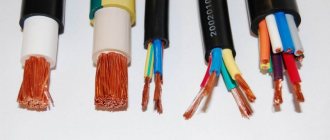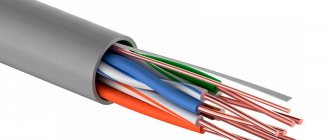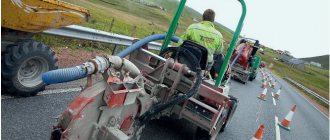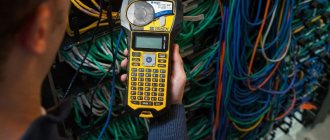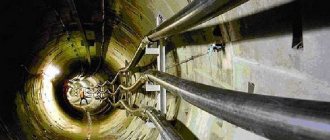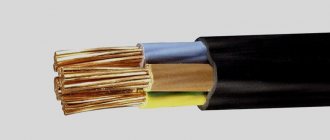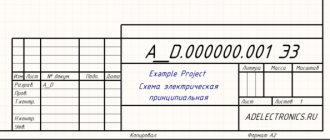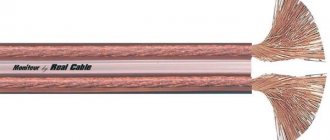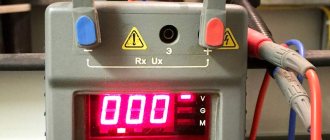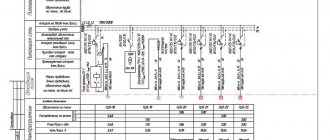Electrical cable
Cable products are widely used in various industries; a large share of the sales market falls on the construction industry. To organize a business, you will need an automatic cable production line, a room where it will be located, equipment operation specialists, and raw materials. Due to the presence of constant demand and high profitability of production, this type of business will quickly recoup the initial investment and generate a profit of about 500 thousand rubles per month.
How cables and wires are made
The process of manufacturing wires and cables is technologically implemented in several steps, the main of which are: stretching the workpiece, applying insulation, and the final stage - winding the finished product into coils. In fact, everything is somewhat more complicated, and at least two large workshops are allocated for cable production - a workshop for processing copper blanks and a workshop for applying sheaths.
In the first workshop, copper wire rod is drawn into wires and twisted, and in the second workshop, the blanks are passed through extrusion lines, where the cable takes on a completed insulated shape and is wound into coils.
Let's, however, look at the technological process of producing cables and wires in more detail and step by step using the example of the production of PVA brand wire.
The raw material for copper cores is the so-called wire rod, which is relatively thick copper billets with a diameter of about 10 mm, and they are supplied to the plant. Here, using a rough drawing machine, the copper wire rod is cold worked - it passes under pressure through a drawing tool, the so-called draw, the channel of which is much smaller in diameter than the wire rod itself.
In this way, a thin long wire is obtained, the diameter of which is many times smaller than the diameter of the wire rod, and the length, accordingly, is greater. The drawing machine produces a skein at the output - thin wires, which will then turn into a multi-wire structure - a wall.
During the wire rod drawing process, the conductive and plastic properties of copper deteriorate, therefore, in order to return the conductor to its proper properties, the resulting wire must first be heated in a vacuum furnace to a certain temperature, and then cooled to room temperature to make it softer.
This procedure is called annealing, and the duration of exposure of the wire in a vacuum furnace and the heating temperature depend on the initial and required characteristics of the wire, as well as on its diameter. After annealing is completed, the strand with the correct electrical and mechanical characteristics is wound onto reels for submission to the next processing step - for twisting into a strand.
To create a flexible multi-wire core of the future wire, individual wires (strand) from several coils are simultaneously fed into a twisting machine, where a conductive core is twisted from them - a strand, which serves as the basis for the future wire. The twist can be different: bundle, cord, regular, and can also have one direction or another (right or left).
Depending on the required flexibility, tensile strength, and other characteristics of the future wire, the type of twist is chosen. United by twisting into a strand, the strands are wound again onto a reel. As you already understand, a strand is a stranded wire ready for insulation to be applied to it.
The strand is fed into the extrusion complex. Here the PVC plastic granules will turn into insulation. The coil with the strand is installed on the output device, from which the twisted strand is fed into the extruder. The core is constantly tensioned with a special tensioner, and is immediately heated to 100–150°C by electric current while it passes along the rollers. PVC plastic granules melted in the screw are converted into a homogeneous mass. The heated wire passes through an extruder, where the molten mass of PVC plastic compound is squeezed onto it, taking the form of a shell.
Operation of the extrusion line in the technological process for cable production:
After leaving the extruder already insulated, the flexible wire passes through an extended cooling bath of water, in which it is cooled to 60°C. Next, the water is blown off the wire with a special device, the insulation is finally dried, and the insulated wire is fed to the shaft, first undergoing a dry voltage insulation test.
The individual insulated strands are finally twisted - this is how a stranded wire is obtained: the twisted strands are fed into a twisting disk machine, and they are compacted. At the final stage of production, the stranded wires are covered with general insulation in the extrusion line, and the finished wire is tested for compliance with GOST. After this, the wire is packaged into coils, and the coils are then shipped.
Source
What is needed to make a cable
The rapid development of the construction industry contributes to the opening of new electrical installation companies. Despite the enormous competition in this area today, the business remains highly profitable. But you can go further by starting the production of cables and wires. And for this we need to know what equipment we need for cable production.
The content of the article:
The production equipment market provides cable equipment in a wide selection.
Cable classification
A cable is a structure consisting of one or more conductor cores, which are insulated from each other and are in a sheath.
Depending on operating conditions, the wires may also contain:
- screen;
- core;
- armor (steel or wire);
- aggregate;
- metal shell;
- outer shell.
The following cables are distinguished:
- power for stationary installation (with voltage up to 35 kW or from 110 kW);
- power for non-stationary laying;
- connections symmetrical and coaxial;
- telephone communications;
- radio frequency;
- management;
- control;
- warming
Also taken into account by characteristics:
- different insulation;
- different screens;
- number of cores;
- veined material;
- flexibility (movable, immobile).
Necessary production equipment
Manufacturing process:
- core preparation: twisting threads of conductive material (aluminum, copper) by drawing;
- the metal is covered with insulation (synthetic plastic, rubber compounds): first, polyethylene granules are heated, and then they are dipped into it in an extruder;
- cooling: pulling the wire through an irrigating bath;
- checking parameters, insulation;
- coil formation;
- twisting of cores: a twisting machine is used;
- production of finished wire insulation: an extruder is required for this process;
- wire armoring (lead, steel).
An automated line for cable production will be more productive, and the product will be of higher quality, which means it can be offered to the foreign market.
Cable production equipment consists of machines for different functional purposes. They can be controlled by one operator.
Starting production requires the following extrusion, drawing, twisting machines, and booking machines.
Extrusion machine
This equipment for the production of VVG cable applies a thin layer of polymer coating (insulation) to the metal core. The machine independently melts polymer raw materials and also gives the material the desired shape.
There are 3 types (differentiated by screw diameter):
Extruder for the production of cable and wire 65/62 – applies insulation to the core. This equipment can be used to produce VVG, TRP, PVA, etc.
Product characteristics:
- core diameter: 1.78 – 10 mm;
- diameter after applying the plastic shell: 3.5 – 13 mm;
- extruder power: 80 kg/h;
- engine power: 15 kW;
- heating power: 16 kW;
- diameter of drums (coils): 400-630 mm.
Equipment includes:
- release device;
- tensioning, straightening device;
- cooling bath;
- device for applying inscriptions;
- drying;
- meter counter;
- traction device;
- receiving device;
- control cabinet.
Cost: 17,600 rub.
Drawing machine
It is intended to perform the drawing method, that is, processing metal by pulling it through a section with a smaller diameter.
The main components of the equipment are dies through which metal blanks are passed. Equipment models are distinguished by drum diameter and number of units.
Drawing machine SV-6
Suitable for ferrous or non-ferrous metals. Produces accurate section dimensions and smooth surface.
Advantages:
- quickly removable drums, including additional ones;
- coolant supply system;
- 6 working dies simultaneously;
- wire threading device;
- soldering clamp;
- sharpening block.
Characteristics:
- maximum material diameter – 2 mm;
- minimum diameter after drawing – 2 mm;
- pump power – 0.37 kW;
- tank volume – 40 l;
- power supply – 380 V;
- drive power – 2.2 kW;
- dimensions – 640x660x1140 mm;
- net weight – 180 mm;
- cost – 278,930 rubles.
Twisting machine
Necessary for combining single parts (cores, wire, strands) into a single object.
They are distinguished by the coils used, the number of cores, tension, twisting and are:
- cigar;
- cages;
- fork;
- arched;
- with a rigid structure.
Cage twisting machine Xm-400/500/630 is cable equipment used for twisting and twisting of cores, insulated power cables, rubber-wrapped electrical cables, symmetrical, nylon cables.
How cable is made
The cable manufacturing technology depends on its design. The more complex the design, the more technological operations are required. Moreover, each technological operation requires a certain type of equipment.
The following operations may be required to manufacture the cable:
- Wire drawing (rough drawing machine)
- Annealing of wire after drawing (annealing installation, usually combined with a drawing machine).
- Twisting of individual wires into a conductive core (twisting machine for aluminum or copper wires).
- Applying insulation of different colors to each core (insulation extrusion line).
- Twisting of insulated cores into a cable blank (twisting machine for insulated cores).
- Application of core or belt insulation (hose extrusion line).
- Application of screens, armor of different types (winding or braiding machines).
- Applying a sheath or protective hose (hose extrusion line).
- Rewinding of the finished cable into transport containers for testing, packaging and transportation to the consumer (rewinding lines when supplied on drums, coiling lines when supplied in coils).
It is better to entrust the calculation of the cable design, the determination of the required number of technological operations, and the choice of equipment for each operation to a competent technologist.
Video links:
How to choose extruder size.
One of the main characteristics of an extruder is its performance, i.e. the ability to extrude a certain amount of melted material per unit of time. Depending on the design, extruders of the same diameter can have different productivity.
The most productive extruders tend to be more expensive.
Depending on the tasks facing the manufacturer - required speeds, required production volumes, etc., extruders are selected according to the following basic principle:
A little about cable production
In order to satisfy all market needs, it is necessary to organize the production of inexpensive but high-quality products. In this regard, automatic cable production equipment should be used in the technological process.
This will ensure high quality that meets not only domestic but also international standards in this area. Such a line consists of a group of machines, each of which performs its own function; together they represent a complete cycle. The advantage of automatic equipment is the simplification of the production process, which is controlled by one operator.
In addition, the productivity of such installations is much higher than semi-automatic ones. The manufacture of cable products is a high-tech process. It is produced by twisting threads of conductive material, applying wire and then placing it in a polymer shell.
All operations are performed by the cable production line. Various materials are used in this process. Thus, conductive threads are made from aluminum and copper, and sheaths are made from lead and steel. Synthetic plastics and rubber compounds are mandatory components in the production of cable products.
What is a cable
A cable is a simple structure that consists of conductor cores placed in a sheath. There are telecommunication and electrically conductive cables; the latter are capable of carrying high voltage current, up to 100 kW. A cable consists of two main components - a conductor and an insulator. Copper is often used as a conductor because it has high electrical conductivity. In addition to copper, you can use:
- aluminum conductors; Cable bus formation
- alloy of copper and cadmium;
- optical fibers.
The following are used as an insulator:
- polyamide;
- polyethylene;
- polytetrafluoroethylene (PTFE);
- rubber.
To resist fire, insulating materials are treated with hydrocarbon lubricant.
What does an industrial line consist of?
Equipment for the production of wire includes closed mixers, rolling machines, calenders, crumb baths, lamination machines, cooling lines and other special equipment. These installations must meet all the requirements of international quality standards, which will ensure their durability and make them convenient to use. Companies involved in the sale of these lines will always provide clients with competent advice, not only in matters of equipment operation, but also regarding the technological process.
Let's take a closer look at the purpose of the main components of the production line.
Extrusion machine
This equipment for the production of VVG cable ensures the application of a thin polymer coating (insulation) to a metal core. The main purpose of such a machine is to melt polymer raw materials, as well as give the material the required shape specified in the extruder.
There are three types of such machines: worm, disk-worm and wormless. Their main difference lies in the diameter of the screw and the speed of its rotation, in the ratio of its length to diameter, as well as in geometric characteristics.
Drawing mill
This cable production equipment is designed for processing metals by pulling them through a cross-section with a smaller diameter - the drawing method. The main component of such a machine is the dies. Metal blanks and special pulling devices that pull the raw materials are passed directly through them. Drum-type drawing machines can be used in the production process. They are characterized by the diameter of the drum. Depending on the machine model, the number of pulling units may vary.
Copper wire production technology.
The main method of producing copper wire is drawing. During this process, copper rod is pulled through holes whose cross-section is smaller than the diameter of the copper rod. As a result, the workpiece becomes thinner, but longer. The same method can be used in the production of copper pipes.
The drawing machine consists of three parts:
- feeding device;
- portages;
- receiving device.
The actual procedure of drawing wire from a wire rod is carried out on dies, the holes of which are strictly calibrated for a certain diameter of the product. They are made from hard tool steel. And dies for wire of especially small diameter (less than 0.5 mm) are made of diamond, a material with unsurpassed strength. They may have one or more holes (drawing eyes or matrices).
In order to avoid damaging the surface of the copper workpiece during the drawing process, the inner surface of the matrix is coated with a special lubricant. Another option for such equipment is a machine in which, instead of holes, special rollers are used, between which the wire rod is pulled.
As a rule, copper wire is produced by cold drawing. This means that the wire rod is not heated before passing through the drawing device, and the heat that appears during the passage of the workpiece through the eyes or rollers due to friction is constantly removed. To do this, the wire rod is cooled with air, water or special compounds. This production technology makes it possible to obtain copper wire with a perfectly smooth and shiny surface, the diameter of which exactly corresponds to the specified dimensions.
